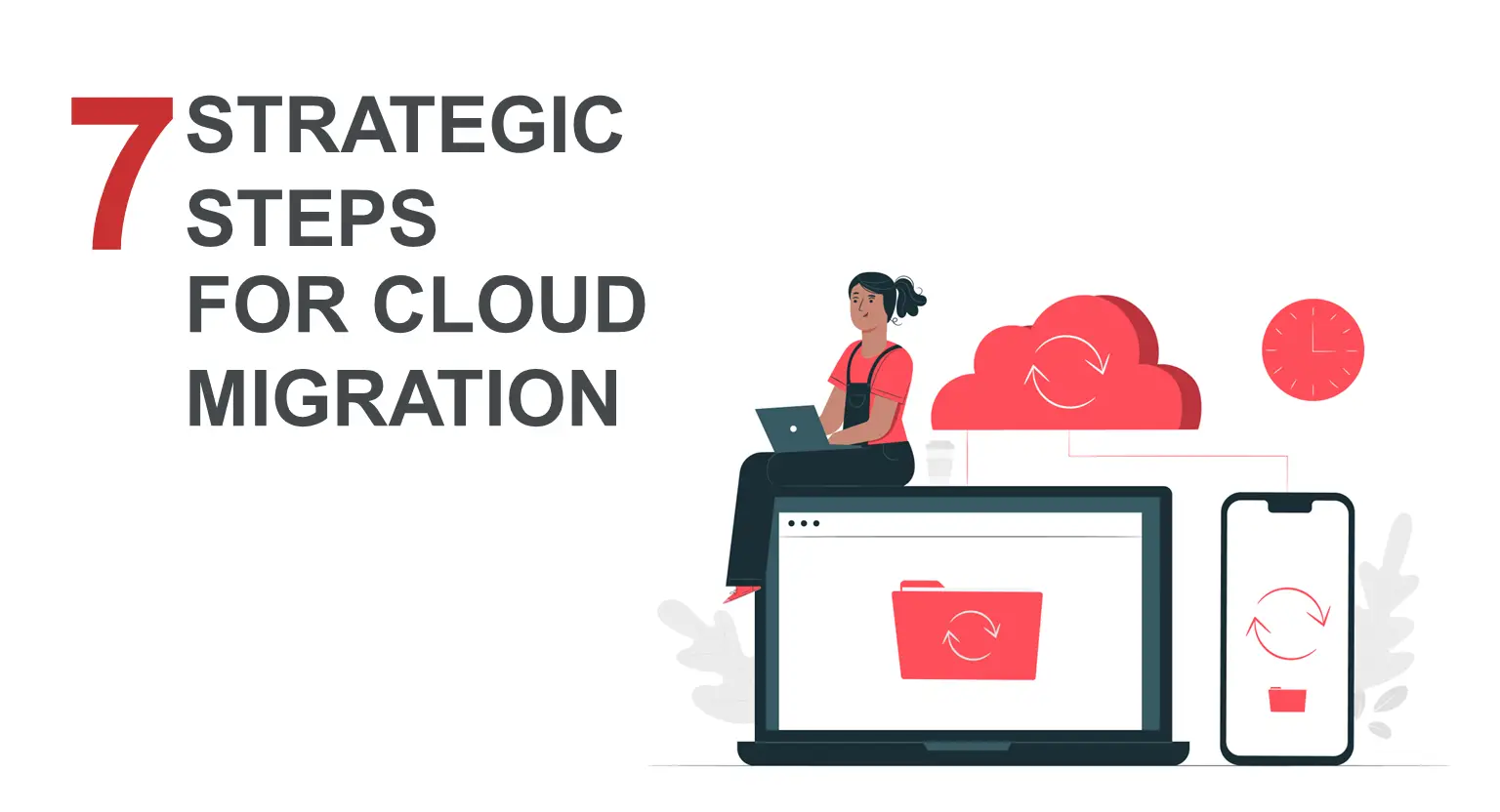7 Strategic Steps of Cloud Migration

1 Minutes 48 Seconds | 4188 views
Listen This Blog Now!
Introduction
Businesses are increasingly using the cloud for a variety of tasks, including processing and storage. For a successful cloud migration, businesses should concentrate on the migration process. A thorough strategy that specifies migration goals establishes a schedule, anticipates challenges, and identifies resources necessary for successful cloud migration.
The following are the 7 steps for smooth cloud migration:
-
Developing A Strategy: To stay focused and narrow your options, establish your goals, and make a reasonable plan. Develop monitoring, governance, and billing policies, estimate the resources needed for cloud migration and decide which legacy programs should be preserved on-premises or shut down. Think about your long-term, tactical, and cloud-native application plans.
-
Assess Your Cloud Options: To suit your unique company requirements, a variety of cloud options can be evaluated with options for programs to be kept, retired, rehosted, re-platformed, or restructured, among other choices, further determining which service framework is most comprehensive to support your migration goals is crucial.
-
Pilot The Chosen Cloud Option: This is where you will determine whether it is feasible to migrate your current applications after you have reviewed and analyzed your current environment, identified workload dependencies, and identified application dependencies. At this stage, it would be helpful if you also determined your total cost of ownership.
-
Investigate The Current Cloud Operational Maturity: This includes assessing people, processes, and technology. Determine each application's readiness for migration and the best migration strategy for each workload. Analyze the cloud's capacity as well as your business drivers.
-
Creating A Cloud Landing Zone: Whether you are evaluating AWS, Microsoft Azure, or Google Cloud Platform, you need to consider security, performance, compliance, technical requirements, and the factors for each cloud provider. You can end up installing multiple cloud options to satisfy the requirements of each application.
-
Deploy A Landing Zone: Make a landing zone to test the first application or collection of applications. This process, which integrates best practices, checks to see if the platform is operating properly and if the application is secure and functional.
-
Migration: You may now move the remaining workload categories to your new cloud environment and make plans for them.
Conclusion
Migrating to the cloud is a challenging process that calls for careful planning and extensive knowledge. Businesses can avoid unpleasant consequences by using a well-planned cloud migration strategy. To assist our clients in transforming their current applications and realizing future-proof business outcomes, CyberNX Cloud Migration offers a range of services from strategy to execution, contact us to learn more.
Table Of Content
- Introduction
- 7 Steps For Smooth Cloud Migration
- Developing A Strategy
- Assess Your Cloud Options
- Pilot The Chosen Cloud Option
- Investigate The Current Cloud Operational Maturity
- Creating A Cloud Landing Zone
- Deploy A Landing Zone
- Migration
- Conclusion
Introduction
Businesses are increasingly using the cloud for a variety of tasks, including processing and storage. For a successful cloud migration, businesses should concentrate on the migration process. A thorough strategy that specifies migration goals establishes a schedule, anticipates challenges, and identifies resources necessary for successful cloud migration.
The following are the 7 steps for smooth cloud migration:
-
Developing A Strategy: To stay focused and narrow your options, establish your goals, and make a reasonable plan. Develop monitoring, governance, and billing policies, estimate the resources needed for cloud migration and decide which legacy programs should be preserved on-premises or shut down. Think about your long-term, tactical, and cloud-native application plans.
-
Assess Your Cloud Options: To suit your unique company requirements, a variety of cloud options can be evaluated with options for programs to be kept, retired, rehosted, re-platformed, or restructured, among other choices, further determining which service framework is most comprehensive to support your migration goals is crucial.
-
Pilot The Chosen Cloud Option: This is where you will determine whether it is feasible to migrate your current applications after you have reviewed and analyzed your current environment, identified workload dependencies, and identified application dependencies. At this stage, it would be helpful if you also determined your total cost of ownership.
-
Investigate The Current Cloud Operational Maturity: This includes assessing people, processes, and technology. Determine each application's readiness for migration and the best migration strategy for each workload. Analyze the cloud's capacity as well as your business drivers.
-
Creating A Cloud Landing Zone: Whether you are evaluating AWS, Microsoft Azure, or Google Cloud Platform, you need to consider security, performance, compliance, technical requirements, and the factors for each cloud provider. You can end up installing multiple cloud options to satisfy the requirements of each application.
-
Deploy A Landing Zone: Make a landing zone to test the first application or collection of applications. This process, which integrates best practices, checks to see if the platform is operating properly and if the application is secure and functional.
-
Migration: You may now move the remaining workload categories to your new cloud environment and make plans for them.
Conclusion
Migrating to the cloud is a challenging process that calls for careful planning and extensive knowledge. Businesses can avoid unpleasant consequences by using a well-planned cloud migration strategy. To assist our clients in transforming their current applications and realizing future-proof business outcomes, CyberNX Cloud Migration offers a range of services from strategy to execution, contact us to learn more.
Share this on: